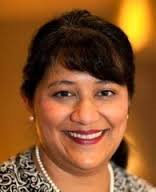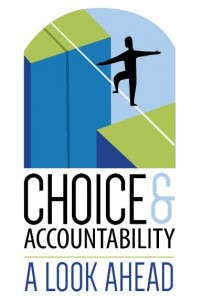
Editor’s note: This is the fourth post in our series on the future of parental choice and accountability.
by Patricia Levesque
Should public, charter, online, and private school choice programs be subject to the same accountability system? This issue came home to Florida this year, with some lawmakers questioning whether tax credit scholarship students should be required to take annual state tests. The rationale is not unreasonable: one system of accountability would allow all sectors of schools to be compared, which would make it easier to determine success and failure. But these arguments simply focus on how we hold different school systems accountable, not who schools should be accountable to: government officials or parents.
So how should things look in 10, 20 and 30 years? If we truly want to create a student-centered system of education that holds all schools accountable to parents, the future will have three key components: choice, customization, and a focus on mastery. Public education needs to transform from a system that funds schools to one that funds the child, where parents take control of their child’s education and direct funding towards the schools, programs, and services that best fit their needs.
Ten years ago, school choice meant being educated in Building A or Building B. Today, a student can attend a traditional school in the morning, classes at community college after lunch, and take AP Calculus on a laptop after basketball practice. This student is taking a customized approach to education – but only within the confines of what the public school system allows. By giving parents control over their child’s education funding, this type of customization won’t be dependent on the permission of a forward-thinking school system; it will be based on the universe of available options and the prerogative of individual families.
At a very small scale, this shift is already happening in Arizona through the state’s Empowerment Scholarship Accounts (ESAs). Designed originally for students with disabilities, ESAs deposit 90 percent of a student’s public school funding into an account, which can be used for multiple educational costs, such as school tuition, online courses, tutoring, therapies, or college savings. This program allows parents to customize their child’s education and, for the first time, creates an incentive for parents to judge K-12 services not only on quality but also on cost effectiveness. Florida recently became the second state to pass an ESA program and many states are sure to follow.
As the definition of public education grows, so will the way we view accountability.
Regulations would be in place to ensure funds are spent in authorized ways. The government could establish guidelines for authorized uses of education dollars, much like it currently does to determine what institutions of higher education are authorized for state and federal financial aid, what can be purchased with food subsidies, and other areas of financial authorization. Arizona’s nascent ESA program is already beginning to tackle these issues, where the state’s departments of education and revenue oversee the distribution, approved expenditures, and oversight of participants.
Ultimately, parents would be the best judges of whether dollars were spent efficiently and effectively. As school choice pioneer Milton Friedman once said, “Nobody spends somebody else’s money as carefully as he spends his own.”
Most disagreements about academic accountability today arise from differing views on how to define school quality. Literacy and numeracy continue to be the core functions of school – and thus, the focus of state accountability systems. Yet, many say it is unfair to limit labels of school quality to just a few subjects. The problem is: if you ask 10 people what should be included, you will likely get 10 different responses.
By giving parents the power to direct their child’s education, accountability will shift to parents – where it belongs. Instead of trying to create one system of accountability for a one-size-fits-all system, growing customization will allow parents to choose from myriad educational options and pick the school that best measures up against their own subjective requirements.
Schools will be obliged, based on consumer demand, to provide information on quality and continually update their offerings to meet the needs of parents. Third-party vendors will create businesses focused on catering to parents’ interest in test scores, college matriculation, parental satisfaction, extracurricular and after-school offerings, and more.
Participating programs would be required to test their students using any approved exam. With almost all schools utilizing some form of standardized test today, this is far from a heavy-handed regulation. Schools participating in Florida’s tax credit scholarship program, for instance, are required to choose from a number of nationally recognized tests and to report results.
As technology improves, testing will seem as natural as getting blood pressure checked at the doctor. Students will be constantly and seamlessly assessed to monitor progress, diagnose weaknesses and create individualized paths for improvement. Parents, who will have access to the same information as schools, will be involved at every step along the way.
Government will not be responsible for choosing which schools to close and which to expand. That will be based entirely on parental demand. If a parent is satisfied with a school, their child stays, along with their funding. If a parent is dissatisfied, they are free to take their child somewhere else. It’s as simple as that.
Additional accountability will come from a move away from antiquated seat-time requirements and towards a new focus on content mastery. Education will no longer be confined within four walls, nine months a year, between 8 a.m. and 3 p.m. Students will not be limited by age, but rather by skill level. Instead of holding back advanced students or pushing struggling ones ahead, students will move ahead when they master the subject. We will be less concerned with what year a student takes Algebra, because the student will take it when she is ready – whether that’s fifth grade or ninth grade. Our developing systems of standards and assessments will act as a roadmap for progression, with schools designing programs to meet, exceed and supplement the standards.
Some may say this vision of education is wishful thinking, but you merely need to look at the numbers for encouragement.
Enrollment in private school choice and charter schools has grown between 300 and 400 percent in the past decade. With 2.5 million students enrolled, charter schools now consist of roughly five percent of public school students. With a million names on waiting lists, limited school availability, and several states continuing to ban charters, it’s clear this reflects only a fraction of the demand.
Of the more than 300,000 students participating in private school choice programs, more than 90 percent live in one of seven states with the friendliest choice policies. Imagine the effect if the remaining states created similar policies.
The number of students taking at least one online course has increased from 50,000 in 2006 to 2.5 million in 2012. Harvard Professor Clay Christensen famously predicted that half of all high school courses will contain an online component by 2019 – a prediction that seems to be come closer to reality each year.
This is not an indictment of public schools. No single school – public or private – can meet the needs of every child, parent, or teacher. A public school might have a science program that is the envy of the state, but lack a strong humanities program that some children crave. A private school can have an amazing humanities program, but lack the attention to arts that a child may thrive under. A charter school might have a renowned arts program, but a school culture that is not the right fit for the child.
Sweden has had a nationwide universal voucher program since 1992. While being interviewed by the Pacific Research Institute, the nation’s former minister of education noted that:
“…we realized how many parents had the ambition of being more active, being a part of the school, taking responsibility for the choice their kids were making … If nothing else would come out of the voucher than parents having to make a responsible decision, that would be enough for me.”
Patricia Levesque is executive director of the Foundation for Excellence in Education.
Coming Friday: Chad Aldis, Thomas B. Fordham Institute’s Vice President for Ohio Policy and Advocacy.



[…] science out of hand, as Patricia Levesque of the Foundation for Excellence in Education does in a redefinedonline.org commentary this morning, is not acceptable as a way forward for our children. What Levesque says is […]
[…] policy radar screen, look no further than this statement from Patricia Levesque published on redefinedonline.org last week. Levesque is Executive Director of the Foundation for Excellence in Education, Jeb […]